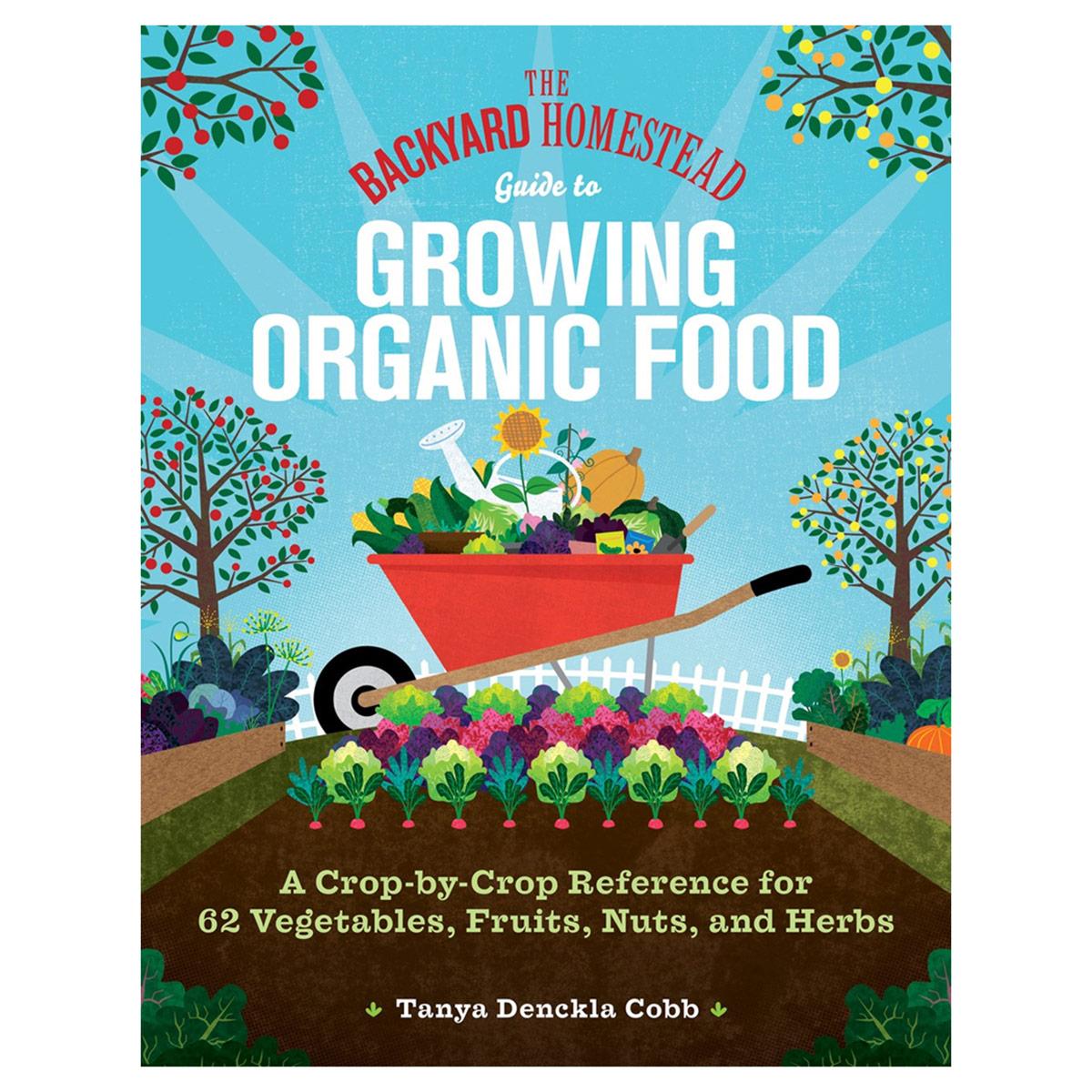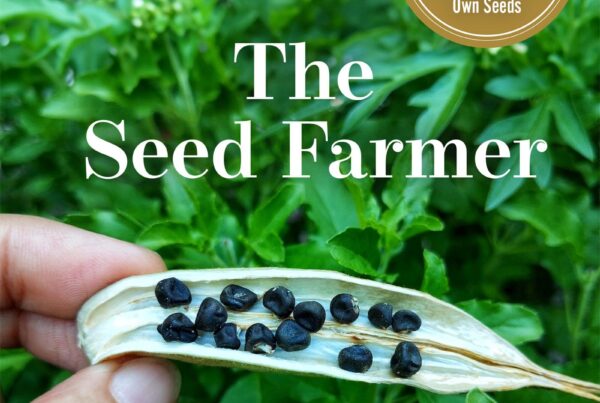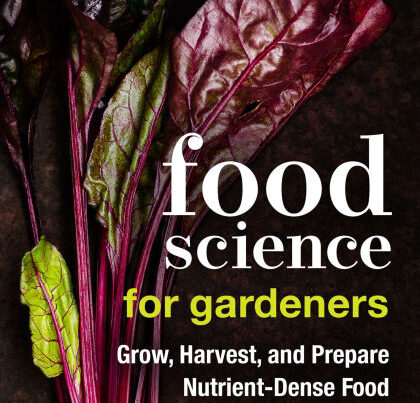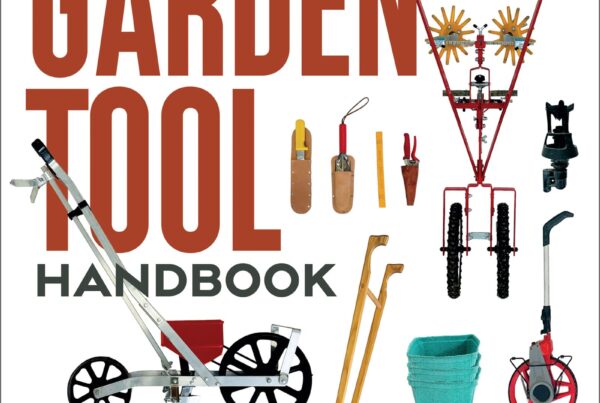Book Review
The Backyard Homestead Guide to Growing Organic Food: A Crop-by-Crop Reference for 62 Vegetables, Fruits, Nuts and Herbs, Tanya Denckla-Cobb 2024, 318 pages, 7″ x 9″, with four full-page drawings by Elara Tanguy. $24.99 Storey Publishers.
This book was previously published by Storey in 2003 as The Gardener’s A-Z Guide to Growing Organic Food, a larger 486-page book with many delightful woodcuts by Stephen Alcorn. That, in turn, was previously published by Storey in 1994 as The Organic Gardener’s Home Reference. I haven’t seen that book. Before that the author wrote a self-published book, Gardening at a Glance.
This is not a new edition. The material on the crops is much the same as the 2003 book, minus the woodcuts, background drawings and the info on varieties. Varieties do come and go, so for a book with a deep future, variety names are not so useful. There’s a new preface. The Organic Remedies chapter has been updated to remove suggestions no longer considered sustainable, and add a few more recent ideas.
The decrease in book size has partly been accomplished by reducing the point size of the text, and using a more compact section heading style. If you are not short of space and simply want the info attractively set out, buy the 2003 book used. If you have the 2003 book, you don’t need to buy this one unless you are moving to a tiny house and need a smaller book – it is 5/8″ thick, compared to 2003’s door-stopper at twice that thickness.
The first chapter provides information to start a garden and a guide on how to use the book. The previous book’s defense of Organic gardening has been omitted. This book is likely to be bought by new gardeners already tending towards organic, and the notion does not need to be belabored.
Having settled the logistics, what is this book like? It’s a quick reference book with the important data you need for sowing and growing many crops, protecting them from problems and harvesting and storing them. There’s a short intro to each crop and its particular attributes, then a well-organized 2-3 page traverse of its temperature, soil and water needs; first and last starting dates (in relation to frost dates); measurements and support structures required; pests and diseases; allies, companions and incompatible plant neighbors; harvest tips and storage requirements both fresh and preserved. The tree chapter includes siting, growing and bearing, shaping, and rootstocks (maybe there is more recent info out there?) The herb chapter includes a sentence on whether each herb will grow well in a greenhouse. This book is for quick reference and does not dive deep into the nuances of growing each crop. It will appeal particularly to new gardeners who need to look things up quickly, without wading through “Everything You Always Wanted to Know About Parsnips” type information.
The “allies, companions and incompatible plant neighbors” sections feel a bit dated to me, harking back to when organic gardeners were more enthused about companion planting. But here, Tanya doesn’t simply repeat the myths and old tales, but lists the allies by “Some evidence” (from recorded field trials), “Anecdotal” (traditional, untested, regard as experimental) or “Uncertain”, and disentangles the threads of plant interactions. Allies are those plants “purported to actively repel insects or to enhance the growth or flavor of the target plant.” The Allies and Companions chapter explains the concepts further and has a chart listing the options. Companions are alleged to grow well together, without any claims to actively promote either plant’s wellbeing. Incompatibles are alleged to hinder each other’s growth, although there is no hard evidence.
The vegetables section covers 28 vegetables, and those not mentioned by name can usually be extrapolated from the information for similar crops. No okra or watermelon, though, or endives, baby lettuce mix, chard, edamame, radishes or turnips. Garlic is in the Herbs section.
The fruits and nuts section covers 17 bush, cane and tree fruits, and tree nuts. I learned that cling peaches are the best for canning, but can be hard for home gardeners to find. I learned that peach trees live a mere 8 years in the south, less with poor drainage.
The herbs section covers the 14 main annual and perennial culinary herbs. And garlic, which I count as a vegetable. I advocate for planting garlic in the fall, long past the “111 days before first frost date” that is given here as the last planting date. And I wouldn’t start planting garlic in spring 21-35 days before the last frost date. I think this chapter needs revising. Garlic is day-length sensitive and doesn’t produce fall harvest from spring plantings – it produces small summer harvests. This section seems to have slipped past the editors.
After the crops section is one devoted to organic remedies for plant diseases and pests. The emphasis is on creating and maintaining a balanced ecosystem, with a reminder not to strive for a blemish-free harvest. It’s good to know that “Most plants can lose up to 20% of their foliage and still match yields of those with no foliage loss.” Determine the severity of the damage, the cause, and the costs and impact of various actions you might take (including none). Then decide the action worth taking. Think of the whole garden, and don’t get sentimental about a particular plant or crop.
The first line of defense is to plan ahead in order to reduce the chances of things going poorly and increase the chances of success. Sunlight, drainage, soil organism diversity, balanced nutrients, all can be optimized. Tilling depth and soil compaction can be minimized. There are brief instructions on hot water seed treatments to reduce seed-borne diseases, for brassicas, nightshades and celery.
The second line of defense is to prevent problems as much as possible. Water adequately, Feed the soil with compost and cover crops, control weeds with mulches and cultivation, maintain mowed borders to reduce incoming problems, remove mature crops, remove diseased plants, protect tender plants from frosts, shade cool weather crops and new transplants, fence out big animal pests. Attract beneficial insects, birds and bats. Consider importing beneficial insects that your garden is lacking. The book has a chart of 14 beneficials and their benefits.
The third line of defense is to accurately identify the problems. This involves regular scouting – touring your garden with a critical and careful eye, trying to find the cause of the problem as well as its name. As in medicine, if you hear hoofbeats, think horses, not zebras. Don’t assume you have every weird virus in all the books. First consider physical problems, then nutrient deficiencies and soil composition imbalances, then pests, then diseases, working through the lists of bacterial, fungal and viral diseases.
To my surprise, the nutrients section does not cover having too much phosphorus, a common issue in organic gardening using lots of compost. It does cover phosphorus deficiency.
The remedies follow the IPM sequence of starting with the least invasive and least toxic remedies, and keep botanical controls for occasions when all else fails. This is an important lesson for old-timey and newly-minted organic gardeners to learn. Don’t reach first for the sprays, even if organic. Attract beneficial organisms before importing any. Ensure you have suitable conditions for the new creatures. Be realistic about costs, ensuring you use enough. For example, beneficial nematodes need to be applied at 50,000 per square foot, when it is warm enough and damp enough for them to survive.
The new book still contains some old-timey methods, such as grinding up bugs and making a soup of them to spray on plants to deter other bugs. Tanya calls this “experimental” which might be too polite. I have not seen any trials proving it works. Clean cultivation was once a favored method of keeping weeds, diseases and pests away. Removing all non-crop plants and dead organic matter, pools of water, brush piles and rocks. Most gardeners these days are more interested in encouraging diversity. Likewise I am not a fan of using home-made dish soap sprays, or dusting plants repeatedly with diatomaceous earth, which desiccates many kinds of insects, not just pests.
Materials previously accepted for pesticide use, such as Ryania, Sabadilla, Roteneone, have mostly been removed from the recommendations as too damaging to many other organisms, and kaolin (Surround) has been added. The neem information now includes the concerns about its harm to non-target organisms.
Insect netting is not mentioned, but rowcovers, stem collars, sticky bands and traps are covered, along with the warning that traps without specific pheromones may catch non-target insects too. I noticed that the spongy moth is sometimes referred to by its older name (Gypsy moth).
Botanical controls to use with caution include the not-actually botanical copper and sulfur (here for convenience of finding the info), as well as Bacillus thuringiensis (Bt), Pyrethrin (concerns noted) and Spinosad (spray in the evening to avoid killing bees).
Next up, after a brief mention of weeds, are plant diseases, with specific suggestions for each named disease. Most of this section seems unchanged from the previous book, and you will need to ID the disease elsewhere first (there are no photos in this book). Not new, but very interesting to me, were foliar spray remedies for Botrytis and some other molds, using juices or oils from various plants, yeasts and a beneficial bacterium. Likewise there are lots of suggestions for dealing with powdery mildew.
Following the specific diseases section is one with pest insects and larger animals.
Chapter 6 covers plant allies and companions, with the advice to “Approach companion planting with skepticism, curiosity and a healthy experimental attitude.” The large chart has been lightly revised, and the print size much reduced. Cilantro (also included as coriander) has been added as an attractant for aphid-eating insects, as well as predators of Colorado potato beetles on eggplant. Mustard greens have been added as a trap crop for flea beetles and harlequin bugs. Mostly, this chart has stayed the same.
The bibliography is half the length it was. The index is 11 pages in this new book, 15 pages in the 2003 book. The new one omits separate listings for Latin names, or for particular Allies. There is a new Afterword that addresses the current state of the organic food movement and the controversies about biosolids, hydroponics, GMOs, antibiotics, irradiation, outdoor access for poultry, and whether the standards for small- and large-scale organic farmers should be the same. Recent and emerging alternatives to USDA Organic certification are covered, and gardeners are encouraged to choose healthy food-growing methods.
Book Review by Pam Dawling, Author of Sustainable Market Farming: Intensive Vegetable Production on a Few Acres, and The Year-Round Hoophouse: Polytunnels for All Seasons and All Climates







